
Keys Cambridge English for Engineering Teachers Notes
.pdf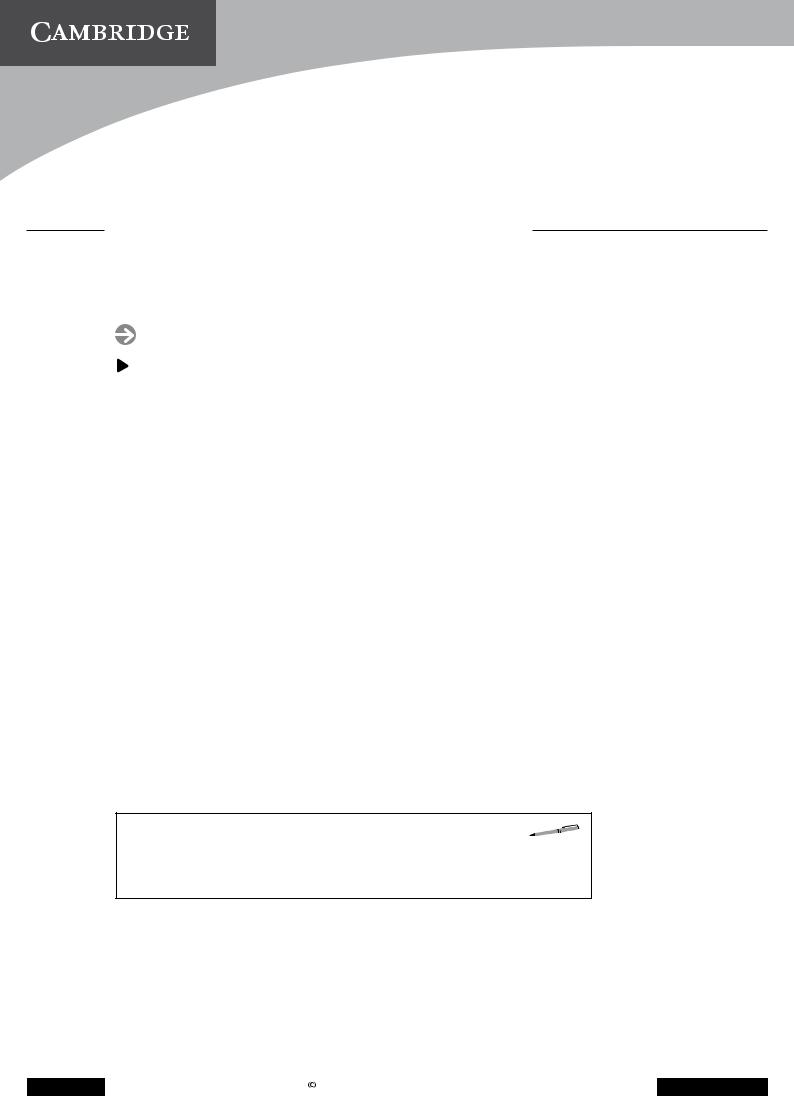
Professional English
Cambridge English for
Engineering
UNIT 1 Technology in use TEACHER’S NOTES
•Describing technical functions and applications
•Explaining how technology works
•Emphasising technical advantages
•Simplifying and illustrating technical explanations
Go to page 10 for essential background information and useful web links.
Refers to Student’s Book pages
Before you begin …
Hold a short introductory discussion to kick off the course as a whole. Use the following questions to cue the discussion. In larger groups, students could work in pairs, or in groups of three or four.
•What field of engineering are you in / would you like to go into?
Branches of engineering include: mechanical, electrical, civil, structural, process/ manufacturing, automotive, aeronautical, highway, coastal.
•How would you describe your branch of engineering to a non-specialist?
•What kind of work do you do / would you like to do within your field? Possibilities include: design, technical management/supervision/project management, product/process development, research, investigation/analysis/ trouble-shooting.
•In what kinds of situation do you / other people in your field need to use English at work?
To introduce Cambridge English for Engineering, invite students to look through the contents list and the book. Explain that the themes and situations, in terms of types of technology, companies and people, cover a wide range of different branches of engineering. Emphasise that although each example is specific, the language of each is useful to all types of engineer. Also explain that the main emphasis of the course will be on listening, speaking and using English actively in practice – through role plays and discussions, rather than learning lists of technical words.
 Describing technical functions and applications
Describing technical functions and applications
Language note
You will find the following vocabulary useful in this section. use, use for ...ing, use to (application), user, useful for ...ing enable to, allow to, prevent from, ensure that
1 a Students complete the tasks in pairs. If they are struggling to come up with examples, you could suggest the following.
mobile phones – phone calls, text messages, exchanging photos and videos, voice recording
electric drill/screwdriver handsets – for providing a turning force, drilling holes, putting in and removing screws, tightening and loosening nuts/bolts
hammers – for generating impacts, for driving in nails, hitting punches and chisels, breaking things
1 |
Cambridge English for Engineering |
Cambridge University Press 2008 |
Photocopiable |
|
www.cambridge.org/elt/englishforengineering |
||||
|
|
|||
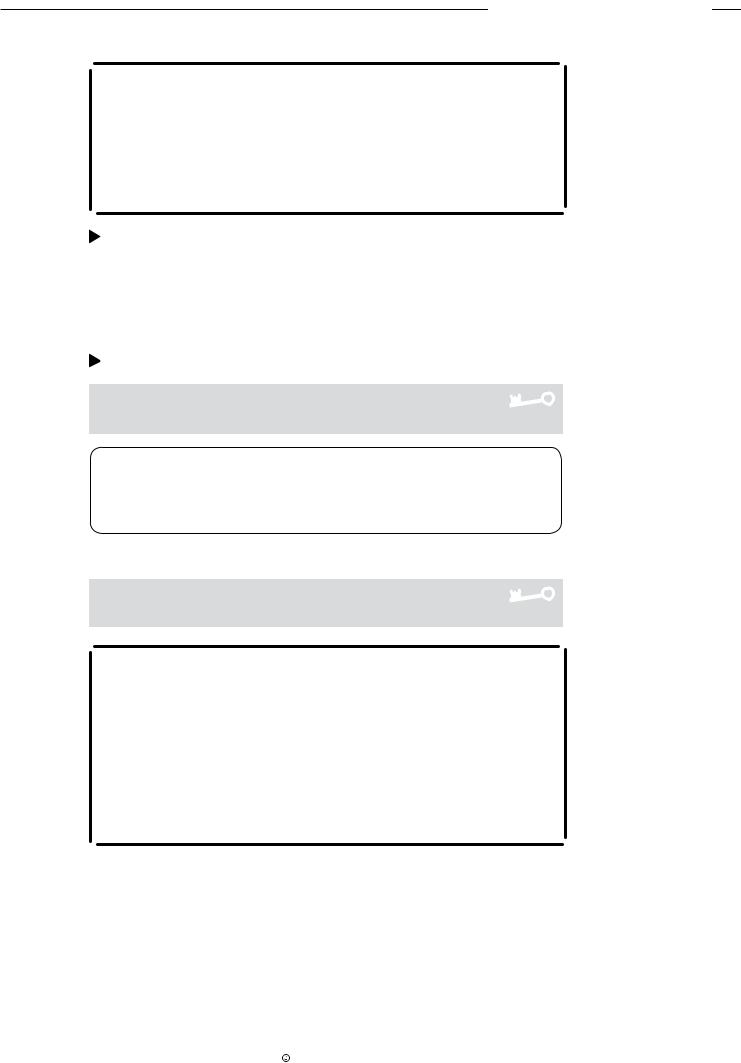
UNIT 1 Technology in use Teacher’s Notes
b Students complete the task in pairs.
Extension activity: GPS
You could ask students the following question.
What do you know about the origins of GPS?
Answer
The system was originally developed for military use in the United States before being made available for civilian use internationally, with some limitations on its precision.
2 a |
1.1 Students listen and complete the notes. |
|
||
|
|
|
|
|
|
Answers |
|
|
|
|
1 |
navigation |
4 |
drift |
|
2 |
(monitoring) delivery vehicles |
5 |
man overboard |
|
3 |
(finding) stolen cars |
6 |
innovative uses of |
|
|
|
|
|
b 1.1 Students complete the extracts and listen again to check their answers.
Answers
1 uses 2 use 3 user’s; useful
Pronunciation focus
Ask students to identify the different pronunciation of s in the following words. Practise saying them.
a use /ju:s / to use /j:uz/ useful /ju:sf@l/ user /ju:z@/
3 a Students match the applications and descriptions.
Answers
2 d 3 b 4 f 5 a 6 e
Extension activity: more vocabulary
You could look at the meaning of some of the terms in Exercise 3a (1–6) in more detail, as well as at related words.
surveying = recording the precise positions of natural features and structures, often in order to draw up maps or plans (a survey/a surveyor)
geological = related to the ground/rocks/soil (geology, a geologist)
civil engineering = the design and construction of large structures such as bridges, dams and skyscrapers, and infrastructure projects such as roads, railways and airports
avionics = electronic systems in aviation i.e. in planes and helicopters maritime = related to the sea/shipping
b Students complete the tasks in pairs.
|
Cambridge English for Engineering |
Cambridge University Press 2008 |
|
|
2 |
Photocopiable |
|||
www.cambridge.org/elt/englishforengineering |
||||
|
|
|||
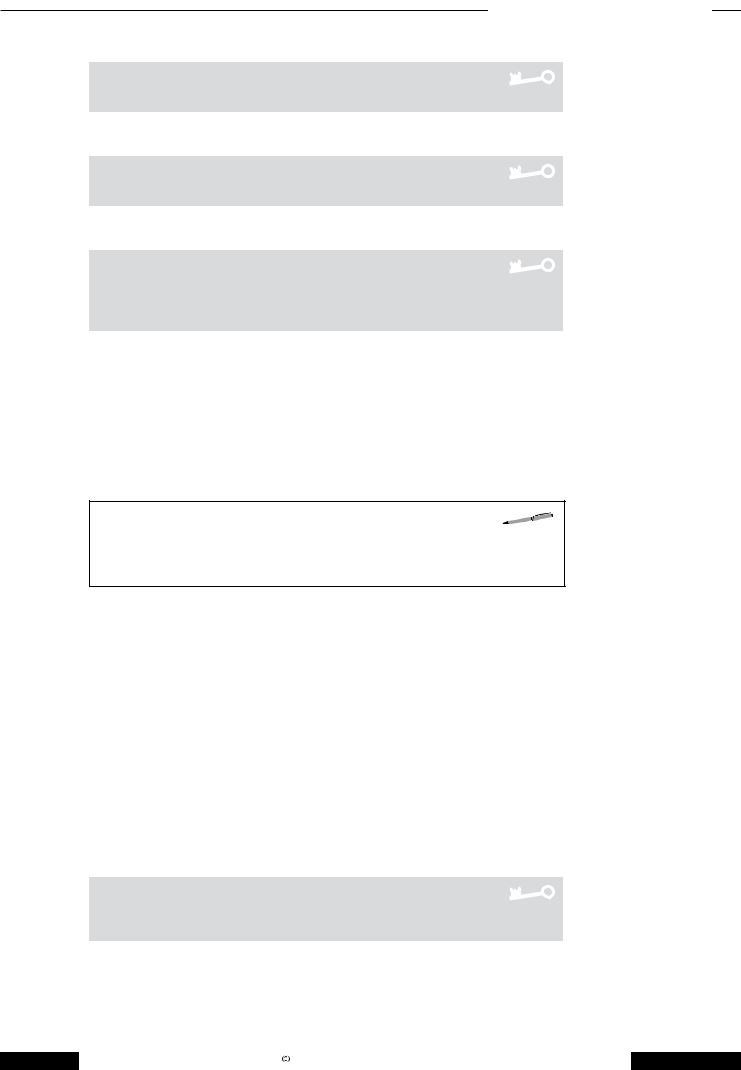
4a
b
c
UNIT 1 Technology in use Teacher’s Notes
 1.1 Students complete the extracts and listen again to check their answers.
1.1 Students complete the extracts and listen again to check their answers.
Answers
1 allows 2 prevents 3 ensures; enables
Students match the words and synonyms.
Answers
1 allows/enables 2 ensures 3 prevents
Students complete the extract.
Answers |
|
|
|
1 |
allow/enable |
4 |
allow/enable |
2 |
allow/enable |
5 |
prevent |
3 |
ensure |
|
|
5 Give out Resource sheet 1a. Each student begins by writing down the name of the chosen product, and make notes of its main applications and functions. You may need to help with specific vocabulary. Students take turns to describe the applications and functions they have listed. To ensure the task is interactive, students should use the phrases in the box to sum up and rephrase what their partner has said.
 Explaining how technology works
Explaining how technology works
Language note
You will find the following vocabulary useful in this section.
attach, fix, connect, link, support, carry, drive, power, propel, control, lift, raise, ascend, transport
6 a
b c
Students discuss the questions in pairs.
Before you begin …
Look at the meaning of the following terms.
space ship vs. space station
payload = meaning load, usually used in the context of space environmentally unfriendly = opposite of environmentally friendly
orbital space = the height above which objects orbit the Earth, rather than falling rapidly back to earth
geostationary orbit = orbiting at the same speed as the Earth spins in order to remain above the same point, above the equator, on the Earth’s surface remote control = controlled from a distance
Students read the article and compare it to their answers in Exercise 6a.
Students match the verbs and definitions, referring back to the article in Exercise 6b to see how the words are used in context.
Answers
2 i 3 a 4 b 5 g 6 h 7 c 8 d 9 f
3 |
Cambridge English for Engineering |
Cambridge University Press 2008 |
Photocopiable |
|
www.cambridge.org/elt/englishforengineering |
||||
|
|
|||

UNIT 1 Technology in use Teacher’s Notes
Language note
7a b
Some of the verbs have more than one meaning: fix
•to attach, for example fix with bolts
•to remain still, for example fixed above a point on earth
•to repair, for example fix a puncture
carry
•to withstand a load, for example the columns carry the roof
•to transport, for example the conveyor belt carries boxes drive
•to control, for example the driver drives the car
•to propel, for example the engine drives the wheels
Before you begin …
Look at the meaning of the following terms. strength-to-weight ratio
This is the strength of a material relative to its weight. Frequently, the stronger a material is, the heavier it is, and vice versa. For example, steel is strong and heavy, and polystyrene is light and weak. Materials with a high strength-to-weight ratio are both strong and light. The metal titanium is an example.
self-contained energy source
Cars have a self-contained energy source, as their fuel is carried on board in a fuel tank. Electric trains use an external energy source – their power is supplied by overhead electric cables.
wireless
Transmission by waves, without a direct wire link.
solar power Converting sunlight to electricity using photovoltaic panels.
Students complete the notes.
 1.2 Students listen and check their answers to Exercise 7a.
1.2 Students listen and check their answers to Exercise 7a.
Answers |
|
|
|
2 |
support |
5 |
power |
3 |
attached |
6 |
ascend |
4 |
raised |
7 |
transport |
|
|
|
|
c Students complete the task in pairs.
Answers
The notes are missing articles (a/an, the) and some auxiliary verbs (e.g. be).
8 a Check students’ understanding of offshore base station= a station, at the bottom of the cable, which is located in the sea/ocean. Students complete the task in pairs.
b 1.3 Check students’ understanding and pronunciation of anchor /{ŋk@/.Students listen and answer the questions.
Answers
1By a floating structure
2To attach the base to the seabed
3Ships would carry them.
4Collisions between the cable and space debris
5The anchors would be raised and the station would be moved.
4 |
Cambridge English for Engineering |
Cambridge University Press 2008 |
Photocopiable |
|
www.cambridge.org/elt/englishforengineering |
||||
|
|
|||

UNIT 1 Technology in use Teacher’s Notes
Before you begin …
Look at the meaning of the following terms.
wind loads = the force of wind blowing against the cable horizontally and trying to push it sideways
propulsion system = system for making something move
propeller = device which causes a ship or aircraft to move, consisting of two or more blades which turn round at high speed
9 a Students analyse the notes in pairs and read them out in full.
Suggested answer
The anchoring system
The wind loads on the cable will be huge. What are the implications for the anchoring system? The base will need to be moved continually and sometimes urgently. What temporary system could be used to hold the base in position? Should the base be in shallow water near the coast, or in deep water further offshore? The choice will have an impact on the design of the anchor system.
The propulsion system
Will the weight of the cable allow the base to be moved by its own propellers or will a more powerful system for propulsion and control be required? For example, an external power source.
b Students complete the task in pairs and then compare their ideas to the suggested answers on page 96.
c d
Suggested answers
Anchor system
It will be possible to anchor the base more securely in shallow water, near the coast. A permanent anchor structure could be built on the ocean bed, in shallow water. The base station could then be fixed securely to it with cables. If several anchor structures are built at different locations along the coast, the base station can be moved between them.
Propulsion system
Tugs (powerful boats used for pulling ships) could be used as an external power source. However, the base station could be driven by its own propellers. The large, powerful engines needed to propel it would be heavy, but that isn’t necessarily a disadvantage, as extra mass, and therefore extra inertia, would help to make the base more stable.
Students complete the task in small groups.
Students complete the task either in class or as a homework activity.
 Emphasising technical advantages
Emphasising technical advantages
Language note
You will find the following vocabulary useful in this section.
conventional, eliminate (problems), superior (quality), (energy-)efficient, enhanced, reduce
completely, significantly, dramatically, entirely, highly, extremely, considerably, totally, exceptionally
10 Students complete the task in pairs.
|
Cambridge English for Engineering |
Cambridge University Press 2008 |
|
|
5 |
Photocopiable |
|||
www.cambridge.org/elt/englishforengineering |
||||
|
|
|||
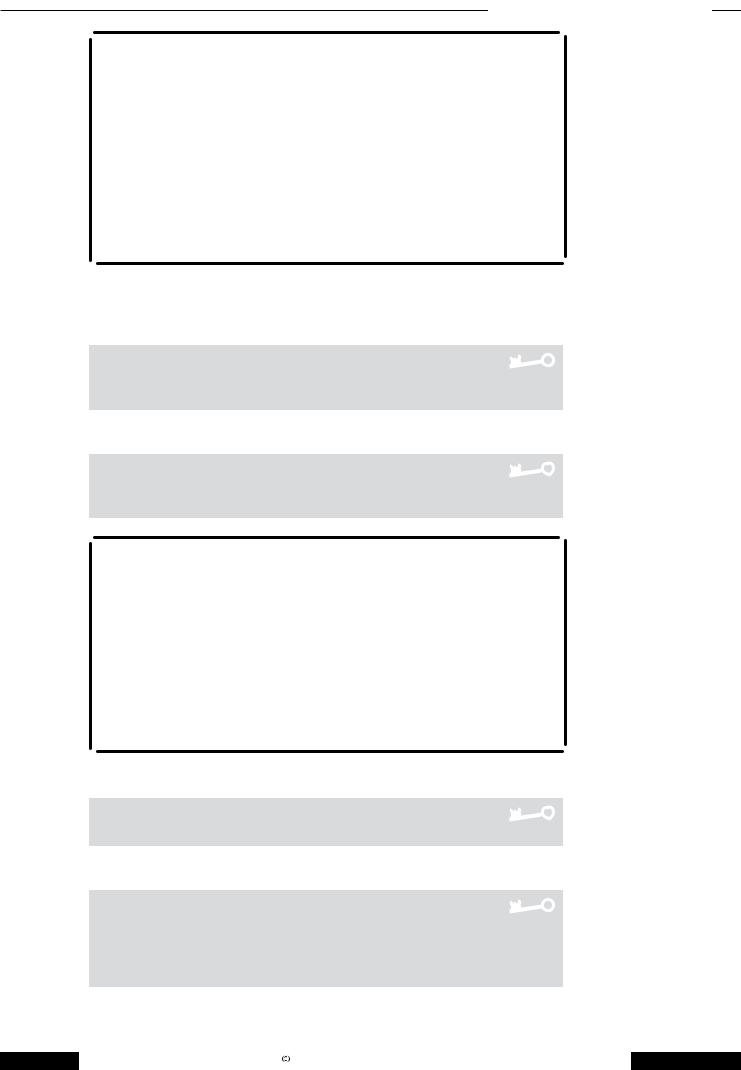
UNIT 1 Technology in use Teacher’s Notes
Extension activity: brand superiority
Ask students which brands have a reputation for technical superiority / high quality in the following areas.
•electrical kitchen appliances (refrigerators, ovens, dishwashers, etc.)
•power tools (electric drills, power sanders, angle grinders, etc.)
•hand tools (hammers, saws, screwdrivers, etc.)
•digital cameras
•vehicle tyres
•performance cars
You could extend the discussion to explore the issue of price. Is the higher cost of some brands justified in terms of quality and durability?
Do any other brands offer better value for money, in terms of quality / technical superiority versus cost?
Before you begin …
You could ask students the following question.
Who are Otis?
Answer
They are an American-based, multinational manufacturer of lifts/elevators. Otis were pioneers of elevators in the mid-19th century.
11 a Students read the text and answer the question.
Answers
It’s a flat belt for lifting elevators which is used instead of a cable.
Compared with cables, the Gen2 system has a number of advantages.
Extension activity: more vocabulary
You could look at the meaning of some of the terms in Exercise 11a in more detail.
belt = a drive belt – belts can have a flat or V-shaped section
cable = a rope made of metal wires – when used for lifting it is also called a wire rope
coated = surrounded by another material – a coating
crowned machine sheave = a sheave is a wheel used in association with a belt, often called a pulley; crowned – describes the section of the wheel, meaning it has a ridge at either side to prevent the belt from coming off
hoistway = a vertical shaft inside a building which houses a lift (British English – lift shaft)
b
c
Students match the words and synonyms.
Answers
2 e 3 b 4 f 5 c 6 a
Students complete the extract.
Answers |
|
|
|
2 |
reduces |
6 |
conventional |
3 |
conventional |
7 |
superior |
4 |
reduce |
8 |
eliminates |
5 |
enhance |
|
|
6 |
Cambridge English for Engineering |
Cambridge University Press 2008 |
Photocopiable |
|
www.cambridge.org/elt/englishforengineering |
||||
|
|
|||

UNIT 1 Technology in use Teacher’s Notes
Extension activity: more vocabulary
You could look at the meaning of some of the terms in Exercise 11c in more detail. gearless = has no gears – gears are cogwheels which mesh together to transfer drive from one wheel to another
wear = progressive degradation due to normal use, for example vehicle tyres cords = wires
machine room = a room in a building where machines, such as lift machinery, airconditioning units and water pumps are located – also often called a plant room, plant being an alternative collective term for machines
d 12 a
Students complete the task in pairs.
Students complete the tips.
Answers |
|
|
|
1 |
enhanced |
4 |
conventional |
2 |
reduced |
5 |
superior |
3 |
eliminated |
|
|
|
|
|
|
b 1.4 Students listen and match the tips to the extracts.
Answers
1 c |
2 b |
3 a |
4 d |
c Students complete the task and then listen again to check their answers.
Answers |
|
|
|
2 |
dramatically |
6 |
highly |
3 |
entirely |
7 |
exceptionally |
4 |
extremely |
8 |
significantly |
5 |
considerably |
|
|
d Students match the words and synonyms.
Answers
1entirely; totally
2considerably; dramatically
3exceptionally; highly
13 Students complete the task in pairs.
7 |
Cambridge English for Engineering |
Cambridge University Press 2008 |
Photocopiable |
|
www.cambridge.org/elt/englishforengineering |
||||
|
|
|||
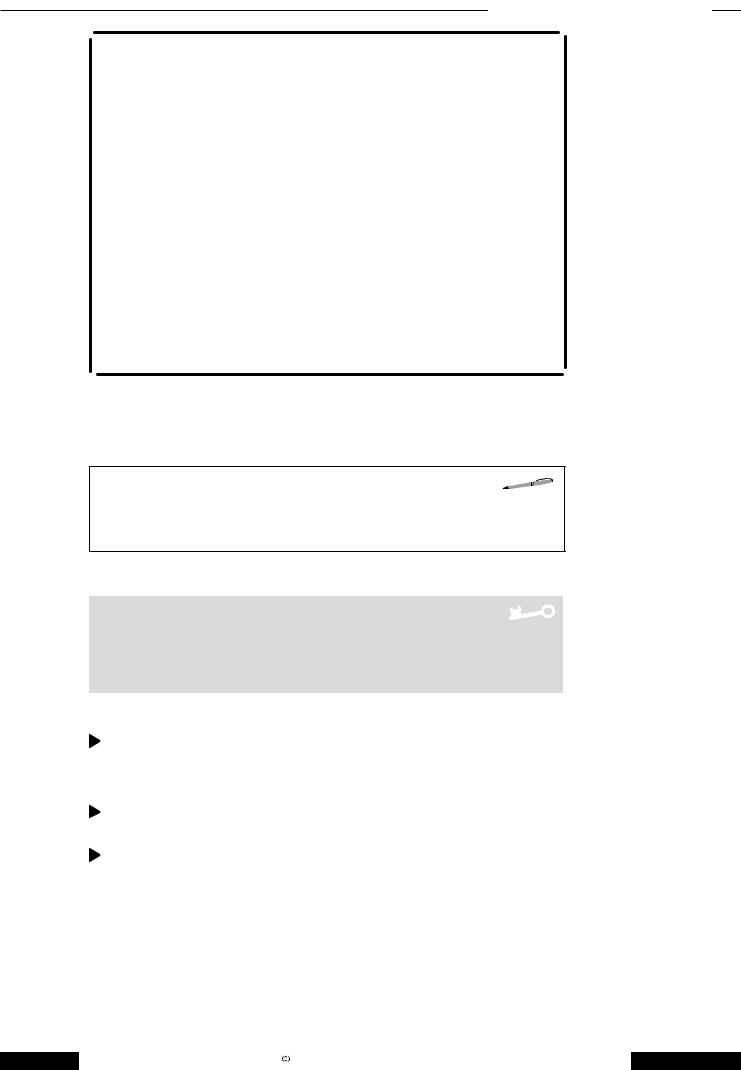
UNIT 1 Technology in use Teacher’s Notes
Extension activity: lift design (Resource sheet 1b)
Give students Resource sheet 1b. Students describe the advantages of lift technology in pairs.
Suggested answers
1This eliminates the risk of someone being trapped inside the lift and being unable to call for help.
2This reduces the temperature inside the lift during hot weather and offers superior comfort.
3This reduces waiting time, making the operation of the lifts more efficient by allowing them to share the work. For example, if someone has called the lift on the third floor and both lifts are ascending, the first lift can stop at the third floor, while the second lift continues, without stopping, to a higher floor (provided nobody already inside it has selected the third floor).
4This means each lift has a shorter maximum travel distance, reducing waiting times. Although people travelling the full height of the building have to change lifts at mid-height, this inconvenience is outweighed by the superior overall performance of the split-level system.
5The 4-door system allows the doors to open twice as fast, enhancing entry and exit speeds.
 Simplifying and illustrating technical explanations
Simplifying and illustrating technical explanations
Language note
You will find the following vocabulary useful in this section.
in simple terms, put simply, in other words, basically, effectively, essentially, what we call … , what we refer to as … , if you imagine … if you picture … jargon
14 a  1.5 Students listen and answer the questions.
1.5 Students listen and answer the questions.
Answers
1That you shouldn’t use jargon or it will sound like nonsense and that technical concepts can be difficult to explain, even using everyday language
2Explanations that are boring
3Speaking to an adult as if you’re talking to a child
b c
15a b
Students complete the task in pairs.
1.6 Students listen and compare the points made with their answers in Exercise 14b.
Students discuss the technical terms and try to interpret the jargon.
1.7 Students listen and make notes and then compare Richard’s explanations with their own ideas from Exercise 15a.
c 1.7 Students listen again and compare the techniques Richard uses to simplify and illustrate the technical terminology with the tips in Exercise 14c.
8 |
Cambridge English for Engineering |
Cambridge University Press 2008 |
Photocopiable |
|
www.cambridge.org/elt/englishforengineering |
||||
|
|
|||

UNIT 1 Technology in use Teacher’s Notes
d Students complete the table.
Answers
1put simply; in other words; basically
2effectively; essentially; basically
3what we call; what we refer to as
4if you imagine; if you picture
e Students complete the task in pairs.
16 Students rephrase the description. This could be prepared as a written exercise with students then reading out their explanations to the group.
Suggested answer
There are two types of pile foundation: end-bearing piles and friction piles. Essentially, end-bearing piles are used when you have soft ground which is on top of hard ground or rock. Basically, the piles go through the soft ground and sit on the hard ground below. It’s a bit like building over water. The soft ground is like water, which can’t support anything, and the hard ground below it is like the seabed. Put simply, the piles are like stilts. Friction piles are different. They’re used when there’s no hard ground. In simple terms, the sides of the pile grip
the soft ground around them. If you picture a nail in a piece of wood, it’s the same thing. The nail is gripped by the wood around it. Sometimes the bottoms of friction piles are made wider. Imagine a leg with a foot at the bottom, it’s the same principle.
17 You could give students Resource sheet 1c to prepare individually.
Students complete the task in pairs, taking it in turns to be the guided tour host and visitor. Although the items of technology being explained will not be visible, the student who is listening should try to picture what is being described, and should regularly rephrase their partner’s explanations, to check understanding.
9 |
Cambridge English for Engineering |
Cambridge University Press 2008 |
Photocopiable |
|
www.cambridge.org/elt/englishforengineering |
||||
|
|
|||

UNIT 1 Technology in use Teacher’s Notes
 Background information and useful web links
Background information and useful web links
Cambridge English for Engineering is designed to be used by engineers, technicians and technical managers from all branches of engineering. The three main branches are:
•mechanical engineering ñ the design and production of machines, for example engines, pumps, vehicle chassis, automated production lines
•electrical engineering ñ the design and assembly of electrical circuits and components, for example power supply networks, electrical controls for automated machines, electrical systems in vehicles
•civil/structural engineering ñ the design and construction of large structures, for example skyscrapers, bridges, dams, tunnels.
There are also many more specialised branches of engineering, for instance, manufacturing/process engineering (production lines / manufacturing plants), automotive engineering (vehicles), aeronautical engineering (aircraft).
The specialised disciplines of engineering, and specific engineering projects, often draw on two or more of the main branches. For example, cars and planes contain both mechanical and electrical systems requiring mechanical and electrical engineers to collaborate closely. Similarly, the design and construction of new power stations requires intricate coordination between mechanical installations, for example turbines, electrical equipment, for example generators and the civil engineering structures that support and house them.
The fact that there is so much interfacing between engineering specialisations means that, beyond the highly specific terminology of their own field, all engineers need to speak the same general technical language, and possess the language skills commonly used in technical conversations. Cambridge English for Engineering teaches this type of language.
Describing technical functions and applications (pages 6 and 7)
This section deals with language for describing what appliances do and what they are typically used for. The theme – global positioning systems (GPS) – represents a wellknown area of technology with a wide range of applications. The language covered
is relevant to describing the purpose of any technological application, whether an individual component or a complex assembly in an electrical device or installation, a mechanical assembly, a structure, a section of a production line, etc.
GPS http://en.wikipedia.org/wiki/GPS
Explaining how technology works (pages 8 and 9)
This section focuses on verbs commonly used for describing how technology works in general terms.
Space elevators http://www.spaceelevator.com
http://www.howstuffworks.com/space-elevator.htm
|
Cambridge English for Engineering |
Cambridge University Press 2008 |
|
|
10 |
Photocopiable |
|||
www.cambridge.org/elt/englishforengineering |
||||
|
|
|||
